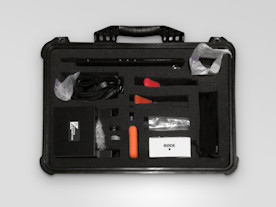In 2019, the Developers team collaborated with the video team to grow a vague idea for a YouTube channel into a full-blown content strategy with three shows, each with its own unique set, theme song, and live-action opening sequence. It took an immense amount of problem solving and behind-the-scenes coordination to make the channel cost-effective and viable to produce. By the time we filmed our last in-person set of episodes in February 2020, we had finally nailed a streamlined process and were ready to crank out content throughout the rest of the year.
Obviously, that didn’t happen. When shelter-in-place orders took effect in March, we had to find a way to work remotely. This meant our talent — the engineers — would have to film themselves in their tiny West Coast apartments, despite having little to no expertise with video. We needed new equipment that had to be shipped to each person at a high cost. Our scheduling and process were in tatters, and there was a host of new technical issues to work through. On top of all of this, the channel’s identity hinged on the use of real props and the unique sets in which we’d invested so much.
You may be wondering, why not just record a voiceover and pair it with a screencast? While this would have been the easiest approach, we believe showing the people behind the work builds a stronger connection with our audience. We also wanted to hold onto our quirky, playful identity because it differentiates our developer channel from our competitors’, while staying more consistent with the rest of our content. Keeping up the high production level was also a must.
We got to thinking about how to shoot remotely while somehow incorporating the set. We considered using a green screen but felt the imperfect lighting would make compositing too challenging. Talent travel was out of the question due to safety considerations. What about robots? Yes. Yes, we built robots and decided to composite our at-home talent into the robots’ heads.

Megan built three robots with different head
shapes and antennae. She embedded lightboxes
into the chest and head to make the composited
footage feel more natural.
To accomplish this, Steven got special permission to visit the office. Wearing a mask, armed with sanitiser and working alone, he assembled the set, rolled in the robot (created by our production partner, Megan Lush), and shot plates of the scene, so we could make it look like our talent was being beamed into the robots. This set us up for quite a bit more backend post-production work for our editor, Ivan Narez, than we had needed in the past.
We use the chest plate for simple animations
that bring the robot to life and reinforce
important moments in the content.
Once we had our plan, assembling a small fleet of video kits was the next order of business. Sourcing this gear to send to our onscreen talent was both more difficult and time consuming than anticipated. Remember early lockdown? Excruciatingly slow delivery times and out-of-stock items were all too common. We had to find gear that our engineers could learn to use with minimal instruction and that was small enough to stash away at home. Each kit consisted of a simple but high-quality camera, lights, audio kits, batteries, hard drives, power cords and travel cases, plus equipment to set up a simple backdrop to make the at-home footage feel seamless with the robot’s head.

The final kit, not including background and lighting gear.
With our kits sourced, Steven unboxed, tested and then assembled each kit. He built a handy step-by-step guide on how to light a room, set up the gear and configure the proper settings. This guide is the foundation for our pre-production day, when our onscreen talent sets up all the equipment, dials in the shots and preps everything with guidance from the production team via a remote video call. We do this the day before we film to ensure the smoothest possible production day, just like we used to do when filming in person.
With the persistence and ingenuity of our trusty team (and a lot of hard work from Steven), we’ve been able to transition into this “at-home” version of our developer YouTube shows. Although we’re still settling into this new reality, with each shoot we’re getting more and more comfortable with the new gear, new responsibilities and the distance of virtual production.
Special thanks to Megan Lush for the creation of the robots and Ivan Narez for editing, compositing and animation.


